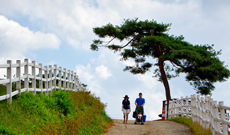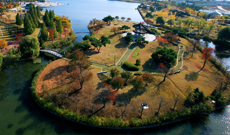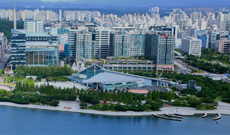- Tourist Attractions
An excellent city to walk around in, Goyang
Get to see the many tourist attractions recommended by Goyang City

- Nature
- Goyang Eco Park
- Ilsan Lake Park
- Spectacular Musical Fountain
- Janghang Wetland
- Bukhan-san
- Baegundong Valley
- Wondang Horse Racing Academy Ranch
- Gongneung-cheon
- history
- Seooreung(Tombs)
- Seosamneung(Tombs)
- Goryeo Gongyangwangneung
- Tomb of General Choe Yeong
- Tomb of Prince Seongnyeong
- Haengjusan-seong (Haengju-san Fotress)
- Bukhansan-seong (Bukhan-san Fortress)
- Heungguk-sa (Heungguk Temple)
- Sangwun-sa (Sangwun Temple)
- Bongseongam Temple
- Goyang Hyanggyo
- Bamgasi Choga
- Songgang-maeul (Village)
- culture
- Goyang Aramnuri
- Goyang Eowulrimnuri
- Goyang 600th Anniversary Museum
- Goyang Culture Center
- The Latin American Cultural Center
- Securities Museum
- Aerospace Museum
- The National Women’s History Exhibition Hall
- Yujin Folk Museum
- Goyang Gawaji Rice Museum
- theme park
- One Mount
- Plantation
- Aqua Planet ILSAN
- Hyundai Motor Studio Goyang
- Astrocamp
- Goyang Children’s Museum
- Baekseok Kids’ Traffic Park
- Theme Park ZooZoo
- Festivals
- International Horticulture Goyang Korea(April)
- Lake Rose Festival (May)
- Goyang Autumn Flower Festival(September~October)
- Goyang Lake Art Festival(October)
- Goyang Open Air Sculpture Festival (October)
- Goyang Lightblooming Festival (December)
- Goyang International Lake Cartoon Festival (October)
- Haengjusan-seong Sunrise Festiva(January)
- Korea Takjoo Festival(October)
- Experiences
An excellent city to walk around in, Goyang
Get to see the many tourist attractions recommended by Goyang City

- Information
An excellent city to walk around in, Goyang
Get to see the many tourist attractions recommended by Goyang City

- About GTCA
An excellent city to walk around in, Goyang
Get to see the many tourist attractions recommended by Goyang City

- Information Plaza
Sangwun-sa (Sangwun Temple)
 Tourist Attractions history Sangwun-sa (Sangwun Temple)
Tourist Attractions history Sangwun-sa (Sangwun Temple) Tourist Attractions
- Nature
-
history
- Seooreung(Tombs)
- Seosamneung(Tombs)
- Goryeo Gongyangwangneung
- Tomb of General Choe Yeong
- Tomb of Prince Seongnyeong
- Haengjusan-seong (Haengju-san Fotress)
- Bukhansan-seong (Bukhan-san Fortress)
- Heungguk-sa (Heungguk Temple)
- Sangwun-sa (Sangwun Temple)
- Bongseongam Temple
- Goyang Hyanggyo
- Bamgasi Choga
- Songgang-maeul (Village)
- culture
- Korean wave
- theme park
-
Festivals
- International Horticulture Goyang Korea(April)
- Lake Rose Festival (May)
- Goyang Autumn Flower Festival(September~October)
- Goyang Lake Art Festival(October)
- Goyang Open Air Sculpture Festival (October)
- Goyang Lightblooming Festival (December)
- Goyang International Lake Cartoon Festival (October)
- Haengjusan-seong Sunrise Festiva(January)
- Korea Takjoo Festival(October)
- Shopping
Sangwun-sa (Sangwun Temple)
| Location | 197-22, Daeseomun-gil, Deogyang-gu, Goyang-si, Goyang-si |
|---|---|
| How to get here | From subway Line 3 Gupabal Station take either bus 704 (Exit 4) or bus 34 (Exit 1) and get off at Bukhansan-seong Entrance. (60 mins hike to temple entrance) |
| Homepage |
www.heritage.go.kr/heri/cul/culSelectDetail.do?VdkVgwKey=21,03540000,31&pageNo=1_1_1_0 |
| 더 자세히 알아보기 |
Located inside Bukhansan-seong, 370, Bukhan-dong, Deokyang-gu, Goyang-si, Gyeonggi-do, Sangwun-sa is a temple directly managed by the Jogye Order of Korean Buddhism.
With the name meaning ‘a temple within auspicious clouds,’ Sangwun-sa is one of the most well-known temples in Bukhan-san and surrounded by beautiful mountain peaks such as Wonhyo-bong, Yeongchi-bong, Baekun-dae, Mangyeong-dae, and Nojeok-bong. Legend has it that Sangwunsa was built by Monk Wonhyo during the Silla Period when he was returning after giving up on studying in Tang Dynasty and temporarily training in Bukhan-san. However, there is no record left to support this and, therefore, this story is considered only a legend at the moment.
The actual foundation of Sangwun-sa dates back to 1722 (Year 2 of King Gyeongjong) by Master Monk Hoesu. According to Bukhan-ji, geographical records compiled by Monk Seongneung in 1745, there were 13 temples in Bukhansan-seong – Jungheung-sa, Taego-sa, Yongam-sa, Boguk-sa, Bogwang-sa, Buwang-sa, Wongak-sa, Guknyeong-sa, Sangun-sa, Seoam-sa, Jinguk-sa, Bongseong-am, and Wonhyo-am – and, with the exception of Jungheung-sa and Taego-sa, all the other temples were allegedly built for defense and management of the fortress.
After the foundation, Sangwun-sa continued its existence as a base of the Buddhist army. Despite its current modest size, the temple used to include over 130 rooms, which were mostly destroyed along with many other temples during the Japanese colonial era and Korean War. However, having survived the history and keeping its place to date, Sangwun-sa is also famous for an ancient Chinese juniper there that allegedly helps people who have fertility issues, and also for the auspicious herbalist Buddha. The beautiful landscape surrounding it makes the temple popular not only among Buddhists but many hikers as well.


.jpg)
.jpg)
.jpg)
.jpg)
.jpg)
.jpg)
.jpg)
.jpg)